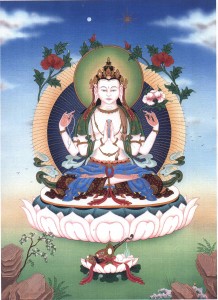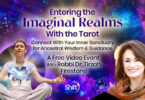
Chenrezig, the Bodhisattva of compassion, holding a piece of lapis lazuli at his heart representing the quality of Bodhichitta.
By Rob Preece – Wake Up World
In a world where sickness of heart is a cultural normality, it’s a long road to the heart of the Bodhisattva
When some of my Tibetan teachers first began to visit the West and teach Westerners, they were surprised or perhaps even shocked by something they experienced in us. When they described it in their own terms, they called it sok lung, a damage or blockage of the primary life supporting “energy-wind” or lung (in Sanskrit: prana ) within the heart chakra. What they recognized in this was that something about our way of life in the West was putting a kind of pressure in the heart that led to a deep yet subtle level of pain and depression of the energy there. One of the ways this manifests is in subtle yet deep insecurity and anxiety.
If we translate this into a more Western, psychological language, what we begin to understand is that there is something about the stresses and pressures we grow up with in the West that has a dramatic impact upon this very subtle energy in the heart. One of the most significant aspects of this problem is that we experience a much more accentuated sense of insecurity and alienation in the West because of the very nature of our culture and its expectations on us from a very early age. From early in our life we are more likely to experience separation from the mother and a far greater expectation to be independent and self-reliant. We grow up into a world that then demands that we survive and become an individual in an extremely competitive environment where the pressure to succeed is endemic. If we add to this the absence of a supportive sense of community and the often dysfunctional nature of the nuclear family, insecurity, anxiety and fear become a root emotional drive.
[pro_ad_display_adzone id=”110028″]
Is it any wonder that this alienation has an impact on the heart and the energy of the heart? The consequence is that we experience deep-rooted wounding to our sense of self, and our ego-identity is built on shaky ground from the very beginning. It was this wounded sense of self that my Tibetan teachers recognized and as a result were at first somewhat at a loss as to how to address it in us. What becomes particularly problematic is that with the degree of wounding we have in the west it has become normal to be self-preoccupied and solely oriented to personal gain and personal gratification at the expense of others. Our culture seems to see the ruthless attainment of one’s own needs in a competitive world as something of an accolade. In the cutthroat political and corporate world being able to achieve and satisfy one’s own aspirations for power and status at the expense of others’ is encouraged. Our sickness of the heart has become a cultural normality.
From a Tibetan Buddhist point of view this wounding to the heart causes a contraction and closing around the heart chakra that cuts us off from a deep essential quality that is innate within us all. This is a quality of mind known in Sanskrit as Chitta. Chitta is often translated as mind, heart or essence and is a quality of mind that dwells in the heart chakra. But this is not our ordinary worldly conceptual mind, it is a deep quality of mind that is essentially clear, peaceful and pervaded by a natural compassion and loving kindness. Indeed it is our ordinary mind with its emotional entanglements and wounds that obscures this essential heart mind.
In the Tantric tradition this essential nature of mind is also known as clear-light mind and has a number of significant characteristics, one of which is its innate clarity and emptiness and the other is a potent innate vitality that brings with it a felt quality of joy, happiness and bliss. Our problem, if we like to see it as such, is that while this natural quality has never been defiled, it is, however, obscured by our gross ordinary mind and its emotional proliferations. As a result it is largely inaccessible to us. It has been described as being like a golden statue wrapped in filthy rags. From a Buddhist point of view if we are able to gradually clear these obscurations, then what naturally manifests is what could be called bodhichitta or the awakening mind or heart.
Our innate heart potential is the deep vitality of our mind’s natural, undefiled and clear nature. So long as we are still caught up in our primary wounds of the heart it is going to be extremely difficult to begin to awaken qualities such as compassion and loving-kindness. If I have deep-rooted feelings of low self-worth, lack of self-acceptance, feeling I am not good enough and so on, then these close the heart leading to Sok lung.
It is very easy to speak of opening the heart and having spiritual ideals of love and compassion, but if we have not addressed our essential wounding these will just be a kind of veneer of spiritual correctness burying deep wounds. To open the heart we must first begin to heal our sense of self. To do this we need to develop compassion and acceptance towards ourselves with all of our failings as well as gifts and qualities. The contraction around the heart then begins to soften, and the innate energy within the heart starts to awaken. This may not always be comfortable because as we soften the contraction in the energy around the heart we re-awaken our wounds, but as we go deeper we can begin to feel the natural chitta that lies in the heart.
The term bodhichitta, which is often translated as the “awakening mind,” emerges from an opening of the heart and brings a deep compassion for the suffering of all beings. It also awakens a powerful quality of intention that is willing to dedicate life to the welfare of others. Bodhichitta is sometimes called the “great will,” but this is not the will of the ego but a deeper intention that requires that we surrender to the process of awakening to the state of wholeness or Buddhahood for the sake of all beings. It is like the shift from “I will” to “thy will be done.” While this “awakening mind” lies at the heart of Buddhist life it is something that emerges only when we have begun to heal our own wounds so that there is the fertile ground for its growth. Once present, as a quality of the heart, it will underlie everything we do in life, like a steady flowing river moving us towards the ocean of full awakening. It will then be natural to wish to dedicate our life to the welfare of others and indeed to the planet that so unconditionally supports us. Bodhichitta is the heart of the Bodhisattva, often translated as “the awakening warrior,” one who with courage engages with the journey of life to transform adversity into the path of awakening for the welfare of others.
About the Author
Rob Preece, author most recently of The Courage to Feel (Snow Lion, 2009) is a psychotherapist, spiritual mentor, leader of Tibetan mediation retreats, and an initiated Granicero (weather work) in the Nahua tradition.
This article was originally published in Sacred Fire magazine
Sacred Fire magazine is an initiative of the Sacred Fire Foundation which seeks to help all people re-discover and celebrate the sacred, interconnected nature of life, a perspective held by indigenous peoples and spiritual traditions everywhere which is the source of all personal, cultural and environmental well-being.
Key initiatives include:
Sacred Fire magazine, which offers a fresh outlook on modern culture by showing the relevance of ancient ways to today’s world
Ancient Wisdom Rising, a series of gatherings with elders and wisdom keepers that offer hope, healing and renewed relationship with our sacred world
Sacred Fire Press, a book imprint that preserves and presents spiritual teachings from ancient and original sources
Wisdom Fellowships, bi-annual awards to tradition holders who are keeping the sacred fires of their people burning.
[pro_ad_display_adzone id=”110027″]






